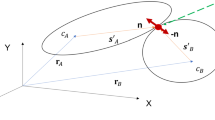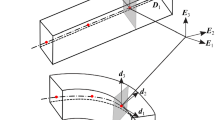Abstract
This paper consists of two parts. The first part presents a complementarity based recursive scheme to model intermittent contact for flexible multibody systems. A recursive divide-and-conquer framework is used to explicitly impose the bilateral constraints in the entire system. The presented approach is an extension of the hybrid scheme for rigid multibody systems to allow for small deformations in form of local mode shapes. The normal contact and frictional complementarity conditions are formulated at position and velocity level, respectively, for each body in the system. The recursive scheme preserves the essential characteristics of the contact model and formulates a minimal size linear complementarity problem at logarithmic cost for parallel implementation.
For a certain class of contact problems in flexible multibody systems, the complementarity based time-stepping scheme requires prohibitively small time-steps to retain accuracy. Modeling intermittent contact for this class of contact problems motivated the development of an iterative scheme. The second part of the paper describes this iterative scheme to model unilateral constraints for a multibody system with relatively fewer contacts. The iterative scheme does not require a traditional complementarity formulation and allows the use of any higher order integration methods. A comparison is then made between the traditional complementarity formulation and the presented iterative scheme via numerical examples.
Similar content being viewed by others
References
Wriggers, P.: Finite element algorithms for contact problems. Arch. Comput. Methods Eng. 2(3), 1–49 (1995)
Hunt, K., Crossley, F.: Coefficient of restitution interpreted as damping in vibroimpact. ASME J. Appl. Mech. 42, 440–445 (1995)
Pereira, M.S., Nikravesh, P.: Impact dynamics of multibody systems with frictional contact using joint coordinates and canonical equations of motion. Nonlinear Dyn. 9, 53–71 (1996)
Pfeiffer, F.: The idea of complementarity in multibody dynamics. Arch. Appl. Mech. 72(11–12), 807–816 (2003)
Trinkle, J., Zeng, D., Sudarsky, S., Lo, G.: On dynamic multi-rigid-body contact problems with Coulomb friction. Z. Angew. Math. Mech. 77(4), 267–279 (1997)
Barhorst, A.A.: On modelling variable structure dynamics of hybrid parameter multibody systems. J. Sound Vib. 209(4), 571–592 (1998)
Pfeiffer, F.B., Glocker, C.: Multibody Dynamics with Unilateral Contacts. Wiley Series in Nonlinear Sciences. Wiley, New York (1996)
Foerg, M., Pfeiffer, F., Ulbrich, H.: Simulation of unilateral constrained systems with many bodies. Multibody Syst. Dyn. 14, 137–154 (2005)
Ebrahimi, S.: A contribution to computational contact procedures in flexible multibody systems. Ph.D. thesis, University of Stuttgart (2007)
Ebrahimi, S., Eberhard, P.: On the use of linear complementarity problems for contact of planar flexible bodies. In: Proceedings of the ECCOMAS Thematic Conference on Multibody Dynamics, Madrid, Spain (2005)
Bhalerao, K.D., Anderson, K.S., Trinkle, J.C.: A recursive hybrid time-stepping scheme for intermittent contact in multi-rigid-body dynamics. J. Comput. Nonlinear Dyn. 4(4), 041010 (2009)
Shabana, A.: Flexible multibody dynamics: Review of past and recent developments. Multibody Syst. Dyn. 1(2), 189–222 (1997)
Schwertassek, R., Wallrapp, O., Shabana, A.: Flexible multibody simulation and choice of shape functions. Nonlinear Dyn. 20(4), 361–380 (1999)
Mukherjee, R., Anderson, K.S.: A logarithmic complexity divide-and-conquer algorithm for multi-flexible articulated body systems. Comput. Nonlinear Dyn. 2(1), 10–21 (2007)
Featherstone, R.: A divide-and-conquer articulated body algorithm for parallel O(log (n)) calculation of rigid body dynamics. Part 1: Basic algorithm. Int. J. Robotics Res. 18(9), 867–875 (1999)
Featherstone, R.: A divide-and-conquer articulated body algorithm for parallel O(log (n)) calculation of rigid body dynamics. Part 2: Trees, loops, and accuracy. Int. J. Robotics Res. 18(9), 876–892 (1999)
Mukherjee, R., Anderson, K.S.: An orthogonal complement based divide-and-conquer algorithm for constrained multibody systems. Nonlinear Dyn. 48(1–2), 199–215 (2007)
Kane, T.R., Levinson, D.A.: Dynamics: Theory and Application. McGraw-Hill, New York (1985)
Stewart, D.E., Trinkle, J.C.: An implicit time-stepping scheme for rigid body dynamics with inelastic collisions and coulomb friction. Int. J. Numer. Methods Eng. 39, 2673–2691 (1996)
Escalona, J., Mayo, J., Dominguez, J.: A critical study of the use of the generalized impulse-momentum balance equations in flexible multibody systems. J. Sound Vib. 217(3), 523–545 (1998)
Escalona, J., Sany, J., Shabana, A.: On the use of the restitution condition in flexible body dynamics. Nonlinear Dyn. 30, 71–86 (2002)
Ebrahimi, S., Eberhard, P.: A linear complementarity formulation on position level for frictionless impact of planar deformable bodies. Z. Angew. Math. Mech. 86(10), 808–817 (2006)
Mukherjee, R.M., Anderson, K.S.: Efficient methodology for multibody simulations with discontinuous changes in system definition. Multibody Syst. Dyn. 18, 145–168 (2007)
Mukherjee, R.M., Anderson, K.S.: A generalized momentum method for multi-flexible body systems for model resolution change. In: Proceedings of the 12th Conference on Nonlinear Vibrations, Dynamics, and Multibody Systems. Blacksburg, VA (2008)
Botz, M., Hagedorn, P.: Dynamic simulation of multibody systems including planar elastic beams using autolev. Eng. Comput. 14(4), 456–479 (1997)
Claus, H.: A deformation approach to stress distribution in flexible multibody systems. Multibody Syst. Dyn. 6, 143–161 (2001)
Shabana, A.A., Yakoub, R.Y.: Three dimensional absolute nodal coordinate formulation for beam elements: Theory. J. Mech. Des. 123(4), 606–613 (2001)
Yakoub, R.Y., Shabana, A.A.: Three dimensional absolute nodal coordinate formulation for beam elements: Implementation and applications. J. Mech. Des. 123(4), 614–621 (2001)
Author information
Authors and Affiliations
Corresponding author
Rights and permissions
About this article
Cite this article
Bhalerao, K.D., Anderson, K.S. Modeling intermittent contact for flexible multibody systems. Nonlinear Dyn 60, 63–79 (2010). https://doi.org/10.1007/s11071-009-9580-2
Received:
Accepted:
Published:
Issue Date:
DOI: https://doi.org/10.1007/s11071-009-9580-2




